#XB-70A
Explore tagged Tumblr posts
Text
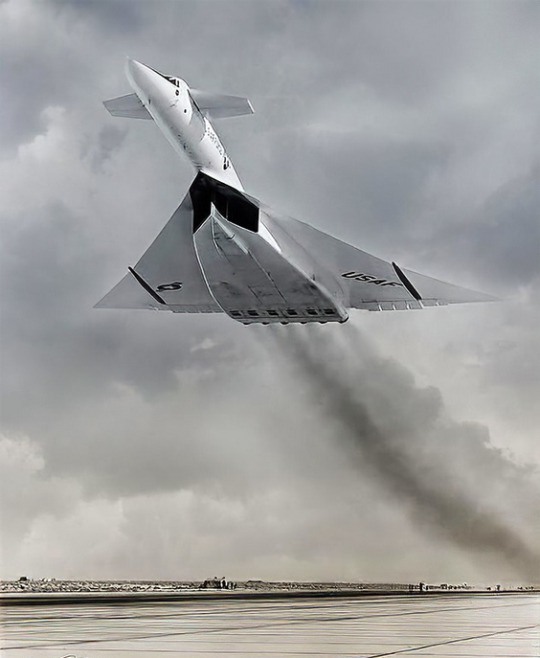
Feb 4th 1969 - XB-70A - Edwards Air Force Base
#North American Aviation#XB-70A#Valkyrie#Prototype aircraft#Vintage aviation#aviation history#supersonic bomber#research aircraft#aviation#aircraft#airplane
349 notes
·
View notes
Text

North American XB-70A Valkyrie
#north american#xb-70a#valkyrie#aircraft#airplane#jet#supersonic#cool planes#prototype#one remains#dayton ohio#usaf museum
6 notes
·
View notes
Text

4 February 1969. Final flight of the North American Aviation XB-70A-1-NA Valkyrie, 62-0001. It flew from Edwards Air Force Base, California, to Wright-Patterson Air Force Base, Ohio and the National Museum of the United States Air Force.
@ron_eisele via X
#xb 70 valkyrie#north american aviation#bomber#aircraft#usaf#sac#nuclear weapons#aviation#cold war aircraft#prototype
97 notes
·
View notes
Text

North American XB-70A Valkyrie, 1964 (60 Years Ago). ➤Edwards Air Force Base: https://youtu.be/XhoCRhJQYao
➤U.S. AIRCRAFT SERIES: https://dronescapes.video/US
#north american#xb 70#valkyrie#aviation pioneer#youtube#aircraft#airplane#aviation#dronescapes#military#documentary#aviation history#airplanes#plane#supersonic#american bomber#air force#atomic bomber#atomic bomb#nuclear bomber#nuclear bomb#1960s#edwards air force base#aviation photography
55 notes
·
View notes
Text

21 September 1964: The first prototype North American Aviation XB-70A-1-NA Valkyrie, serial number 62-0001, flown by Chief Test Pilot Alvin S. White and Colonel Joseph F. Cotton, U.S. Air Force, made its first flight from Air Force Plant 42, Palmdale, California, to Edwards Air Force Base. Originally a prototype Mach 3 strategic bomber, 62-0001 (also … Continue reading 21 September 1964 .
15 notes
·
View notes
Photo
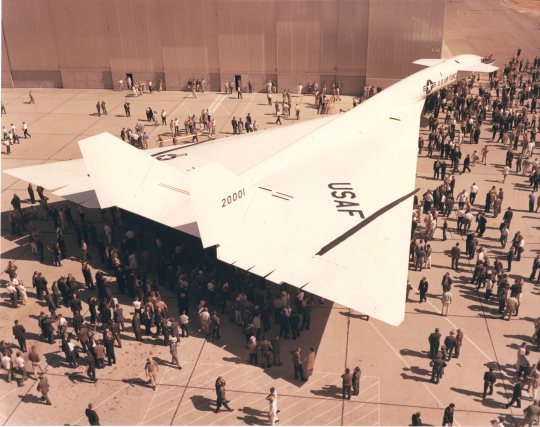

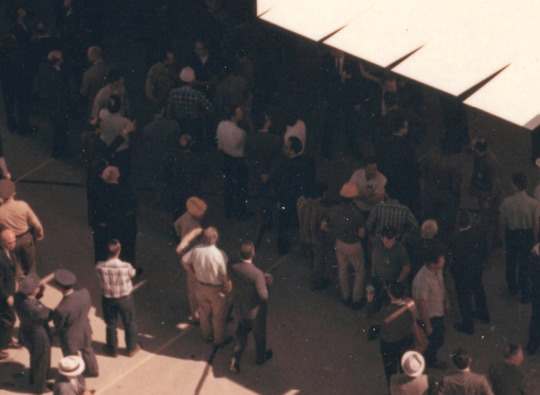
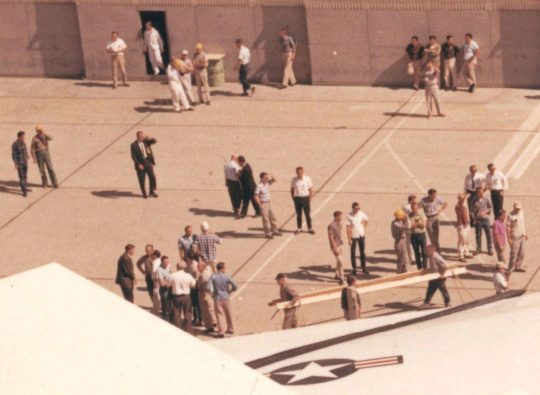
USAF/North American XB-70A Valkyrie rollout, North American Aviation facilities (USAF Plant 42(?)), Palmdale, CA, 11 May 1964.
excellent hi-res scan
via Mike Acs/Flickr
61 notes
·
View notes
Text
North American XB 70A Valkyrie... Prototype replacement for the USAF's long-range bombers such a the B-52 and the B-58 Hustler. The XB 70 could fly at Mach 3 at 70,000ft. At the time, no other aircraft in existence could touch it but Russian surface-to-air missile development took away that advantage and forced the XB 70 to fly at much lower levels which made it only slightly more effective than what the Air Force already had at a much greater cost. Only two were built. First flight was in 1961 and they were kept in operation until 1969 for supersonic research purposes. In 1964, one crashed into a F-104 Starfighter while flying in close formation and the other is part of the display at the National Museum of the United States Air Force near Dayton, Ohio.

176 notes
·
View notes
Photo
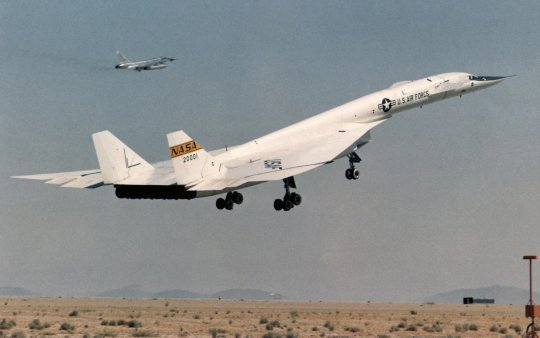
XB-70 Valkyrie with TB-58 chase plane
The XB-70A #1 is seen taking off on a research flight, escorted by a TB-58 chase plane. The TB-58 (a prototype B-58 modified as a trainer) had a dash speed of Mach 2. This allowed it to stay close to the XB-70 as it conducted its research maneuvers. When the XB-70 was flying at or near Mach 3, the slower TB-58 could often keep up with it by flying lower and cutting inside the turns in the XB-70's flight path when these occurred.
65 notes
·
View notes
Video
62-0001 North American XB-70A-1-NA Valkyrie, USAF Museum, Wright-Patterson AFB, August 1974 by Gordon Riley Via Flickr: Heavily restored in Photoshop 2023 due to massive damage done to the negative when it was processed by Wallace Heaton on my return to London in 1974.
4 notes
·
View notes
Text
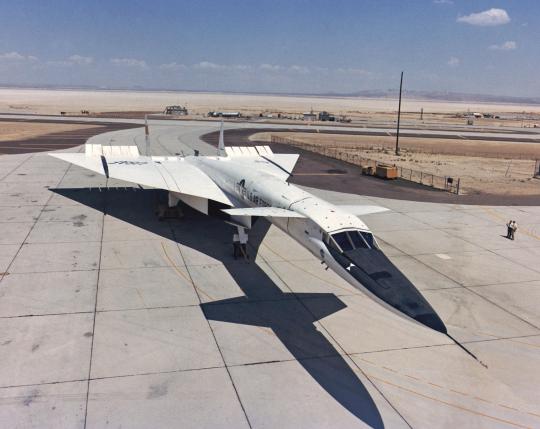
XB-70A - Edwards Air Force Base - 1967
#North American Aviation#XB-70#Valkyrie#Nuclear bomber#bomber#X Plane#prototype#Experimental aircraft#aircraft
146 notes
·
View notes
Text





The first North American XB-70A Valkyrie (SN 62-0001) in flight, circa 1960s.
NARA: 6362754, 6362753
061122-F-1234P-022, 061122-F-1234P-021, 061122-F-1234P-020
#North American XB-70 Valkyrie#B-70#bomber#United States Air Force#US Air Force#USAF#color photo#1960s#my post#undated
119 notes
·
View notes
Text




21 September 1964, XB-70A number 1 (62-001) made its first flight from Palmdale to Edwards Air Force Base, CA. On landing, the port side main gear wheels locked resulting in tyre blow-out and fire.
@ron_eisele via X

60 notes
·
View notes
Text

Lockheed F-104G aircraft lined up at Ingolstadt Manching Airport Germany. | Photo: Unbekannter Autor
FLIGHTLINE: 116 - LOCKHEED F-104 STARFIGHTER
The F-104 was designed as a simple, lightweight interceptor with maximum altitude and climb performance.
Springing from the mind of Kelly Johnson and his team at Lockheed, the F-104 was developed in the early 1950s as a blindingly fast, high flying interceptor to engage Soviet bombers. Based on interviews with pilots returning from the Korean war, Johnson wanted to reverse the trend in the USAF toward increasingly heavy and complex fighters. The USAF seemed to agree, issuing a operational requirement on 5 November 1952 for a lightweight day fighter to supplement, if not ultimately replace, the F-100 Super Sabre. In addition to the Lockheed design, which had been given the internal designation L-246, Republic Aviation proposed their AP-55, derived from the XF-91 Thunderceptor, North American advanced the NA-212, which was developed from the F-100, and Northrop submitted their N-102 Fang.
Lockheed was awarded a development contract on 12 March 1953 for two prototypes of the newly-christened XF-104. The initial design had changed in the interim, with data gleaned from the and X-7 programs being incorporated into the new interceptor. The XF-104 now featured a long tubular fuselage, dominated by a single massive J79 turbojet and featuring small wings so thin that they needed covers during maintenance, lest ground crew cut themselves. The V-tail and variable-position horizontal stabilizers had given way to a single T-tail with an all-moving stabilizer.

Schematics of the F-104. | Illustration: Bagera3005 @ DeviantArt
The first flight of XF-104 #1 took place in March 1954, powered by a Wright J65 engine as the J79 was facing issues in development. The XF-104 had small, trapezoidal wings like the X-3 and X-7, and as such the fuel and landing gear would need to be contained in the fuselage. Because the wings and tail were nearly the same size, the wings were given a 10° anhedral to counteract a tendency to Dutch Roll. The high T-tail led to Lockheed installing a unique downward-firing ejection seat, so as to not injure the pilot if he struck the tail. This feature was removed in the production F-104 as ejection seat technology improved. Both XF-104s were lost during the test program, though enough data was acquired that the production F-104A featured numerous improvements and modifications.
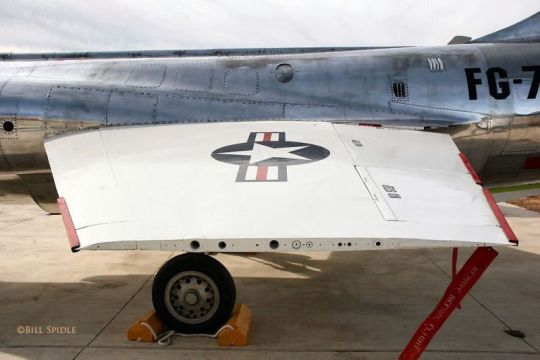
F-104A showing leading and trailing edge covers. | Photo: Bill Spidle
The Starfighter saw service in the USAF from 1958 until 1969, though use continued with the Puerto Rican Air National Guard until 1975. The plane was widely exported, serving in the air forces of 14 other nations, as well as NASA. Canada, Italy and Japan license-built their own copies, with the CF-104 being modified to perform nuclear strike and recon roles, the F-104S designed to fire AIM-7 Sparrow missile, and the F-104J, which resembled the F-104G, but retained the original F-104A’s interceptor-only role.
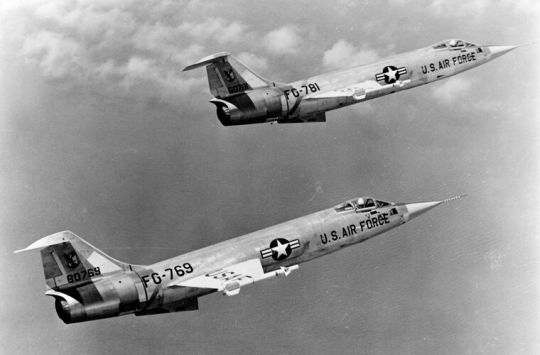
A pair of USAF F-104s, circa 1960, with Buzz Numbers visible on the aft fuselage. | Photo: USAF

An F-104 shooting down a QF-80 drone during a test. | Gif from a USAF film
The F-104C was a fighter bomber variant developed for the USAF's Tactical Air Command (TAC). The radar was improved, and two pylons were added to each wing, along with one under the fuselage, allowing the plane to carry rockets and conventional bombs, along with a single Mk.28 or Mk.43 nuclear weapon. The C model was also equipped with aerial refueling equipment. TAC's F-104C served in Vietnam from 1965 through 1967 before being supplanted by the F-4. Starfighters under the direction of EC-121 Warning Stars shot down 25 MiGs during the war, and 15 F-104s were lost to SAMs, AAA, engine failure, one air-to-air kill by a PLAN J-6, and one mid-air collision.
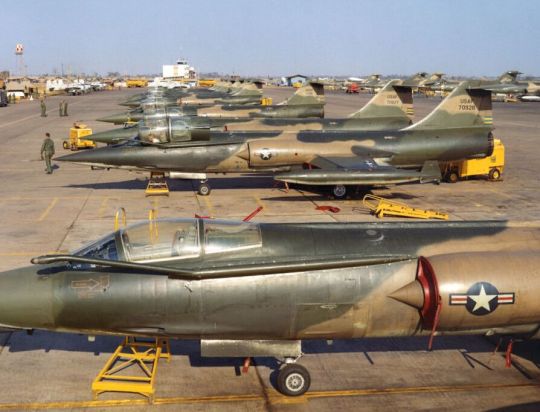
TAC F-104C Starfighters from the 435th Tactical Fighter Squadron, 479th Tactical Fighter Wing, at Udorn Royal Thai Air Force Base in 1965. | Photo: USAF
The F-104G was the definitive variant, and 1,127 were produced by Lockheed, Canadair, and a consortium of Messerschmidt/MBB, Fiat, Fokker and S.A.B.C.A. The type featured a strengthened fuselage, wing, and empennage structures; the larger vertical fin with fully powered rudder as used on the two-seat versions; fully powered brakes, a new anti-skid system, and larger tires; revised flaps for improved combat maneuvering; and a larger braking chute. The G model was also a multi-role aircraft, with 7 hardpoints under the wing and fuselage allowing carriage of AIM-9 Sidewinders, unguided bombs and rockets, and fuel tanks.
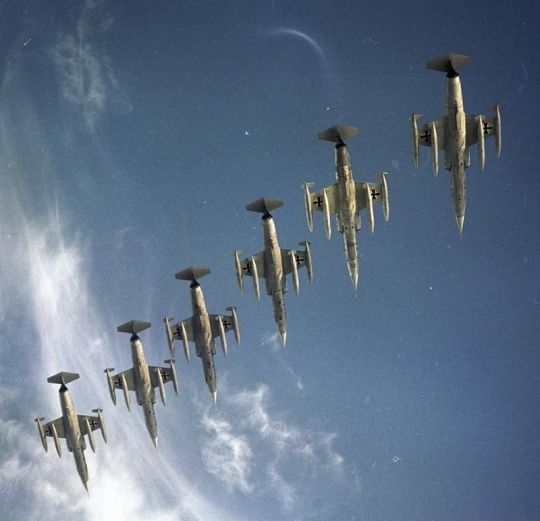
A formation of F-104Gs from the air arm of the German Navy in 1965. | Photo: Marineflieger
It was this multi-role aspect that interested the international community, and the so-called “Deal of the Century” was struck (with bribes greasing the wheels along the way), allowing Lockheed’s new mount to replace a large number of aging first-generation jets. West Germany acquired 915 Starfighters, with 151 going to the Marineflieger and the rest to the Luftwaffe. Though an adequate fighter-bomber, the F-104 design was optimized for high-speed, high-altitude flight, and the adaptations to low-altitude flight were not entirely effective. The plane quickly gained a reputation as being accident-prone, with 270 aircraft lost in West German service and 110 pilots killed. The press dubbed the plane Witwenmacher (‘widowmaker’), and the running joke being “How do you get an F-104 for cheep? Buy a plot of land in West Germany and wait.”. Still, the plane soldiered on in Luftwaffe service, surviving past reunification and being finally retired in 1991.
NASA acquired F-104As in 1963, which were then modified with the addition of a Rocketdyne AR2-3 rocket engine in an angled housing beneath the tail fin, as well as hydrogen peroxide reaction control thrusters, and were used to train pilots for the X-15 and X-20 DynaSoar. One of these NF-104As was lost during a test flight by Chuck Yeager, which was depicted in the book The Right Stuff, as well as the film that was adapted from it.

A NASA NF-104A executing a rocket-assisted zoom climb. | Photo: USAF
Three F-104G aircraft were also acquired by NASA in 1963 for use as high-speed chase aircraft under the designation F-104N. One of these aircraft was famously lost in a mid-air collision with the XB-70A Valkyrie bomber, killing both Joe Walker, pilot of the F-104, and Carl Cross, co-pilot of the XB-70. The other aircraft remained in NASA service until 1994, making it the last Starfighter in US service.
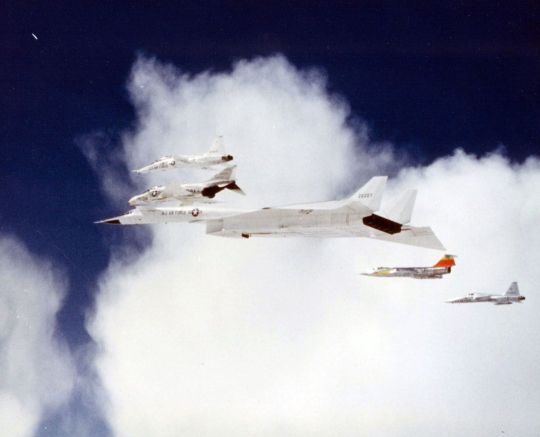
A formation of USAF and NASA aircraft in 1966, From foreground to background they are a T-38A, F-4B, XB-70A, F-104N and YF-5A. The flight had been set up at the behest of General Electric, which manufactured the engines in all 5 craft. | Photo: USAF
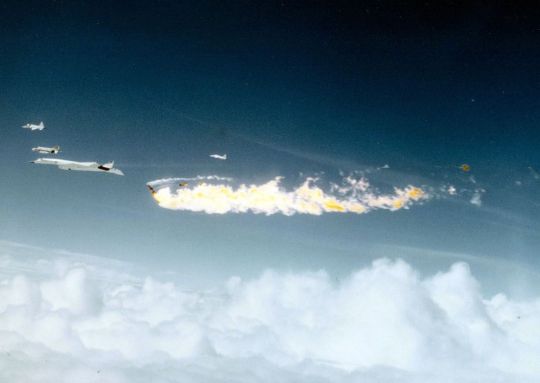
The immediate aftermath of the collision. Investigators determined that Joe Walker in the F-104 lost sight of the XB-70 and drifted into the larger plane's wake vortex, which catapulted the Starfighter across the Valk's back. | Photo: USAF
The F-104, in various models, served with the armed forces of 15 nations, along with NASA and at least one civilian demo team. Italy was the last user, with the F-104S being retired in 2004.
#aircraft#aviation#avgeek#cold war#airplanes#cold war history#airplane#coldwar#usaf#aviation history#Lockheed#lockheed f-104#starfighter#vietnam war#f104#f 104
68 notes
·
View notes
Photo

On June 8th, 1966, XB-70A No. 2 was in close formation with four other aircraft (an F-4, F-5, T-38, and F-104) for a General Electric photoshoot, manufacturer of the engines of all five aircraft. After the completion of the photoshoot, the F-104 drifted into contact with the XB-70's right wing, flipped over and rolled inverted over the top of the Valkyrie, striking the vertical stabilizers and left wing of the bomber. The F-104 exploded, destroying the Valkyrie's rudders and damaging its left wing. With the loss of both rudders and damage to the wings, the Valkyrie entered an uncontrollable spin and crashed into the ground north of Barstow, California.
4 notes
·
View notes
Photo

XB-70A Landing by Douglas Castleman [3840x2160] shared by acoolrocket via /r/wallpapers https://ift.tt/2A5wRQ5
1 note
·
View note

